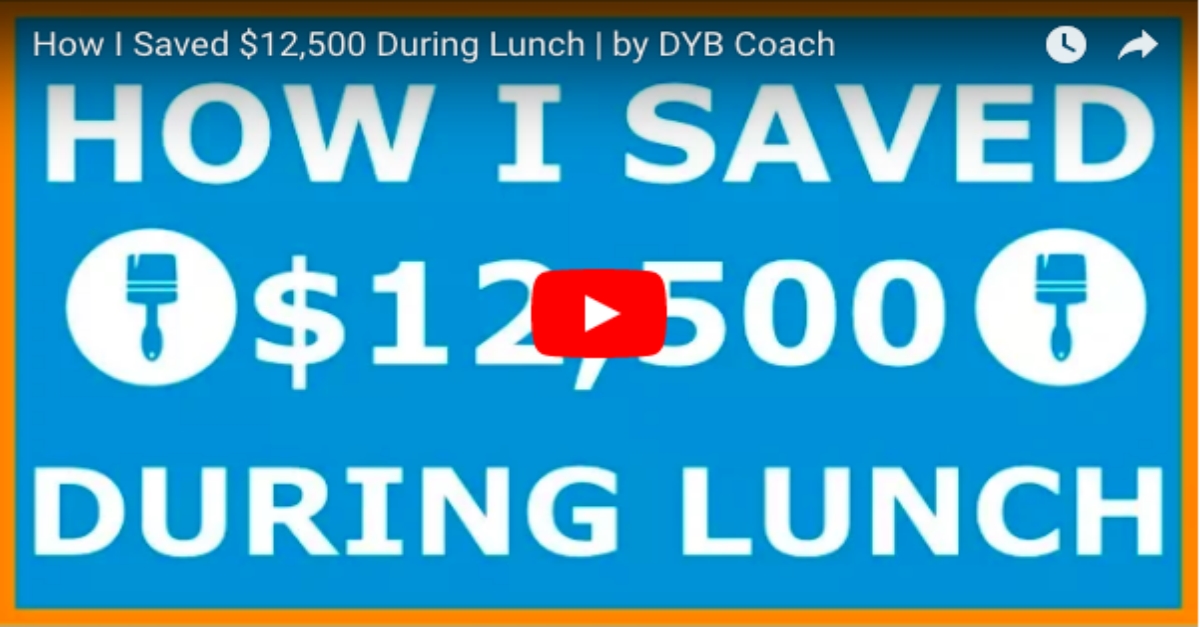
Do you want to know how I saved $12,500 at lunch?
See if you can relate to this…
You get to the job site on a Monday and ask the guys what they worked the previous week.
We used to do paper time cards, I’d show up and say, “Hey guys I need your time cards.”
A couple of the guys would always have them filled out and hand them to me, a couple of other guys would run back to their trucks, talk amongst each other, hand me some cards.
Some of the other guys would fill out another card, I ended up with 5 or 6 cards in my hand. Amazing that they all worked 8am-4:30 pm, nobody was ever late, no-one ever left early and they took exactly a half hour for lunch.
Do you ever come across this with your employees?
I am Ron Ramsden and I am a DYB coach, also a painting contractor up here in Massachusetts.
Download Your FREE Checklist...
11 Interview Questions For Hiring All-Stars, E-mailed to you NOW!

That used to happen to me all the time, but what really opened my eyes was this:
I was actually with the guys at lunch one day and we were working down the street from my house, so I went over there, just to chat and it was about lunchtime, so I showed up for lunch.
I had 6 guys on this job, 4 of them brought their lunch and 2 didn’t.
2 guys stayed back and ate their lunch, the other guys jumped into the car to go to the sub shop.
They got their subs and then came back, they sat down and ate, and then they all got up together and went to work.
That was 40 minutes.
Okay, I don’t want to be a jerk, I don’t want to be so tight that I can’t give 40 minutes, but let’s break down some numbers to show you what 10 minutes at lunchtime that day cost me.
If that happened that day, there is a good chance that it happened every other day.
Let’s do it this way, it just cost me, $12,500.
So, $12,500, that’s what lunch cost me the other day, I couldn’t really write off, no one was punched in, there was no production made, just $12,500.
The way I came up with that number is this:
I had 6 men, who took 10 minutes a day extra for lunch, and I am not saying they did it on purpose, that was just what happened, time flies.
That equals 1 hour a day, so as a result of that 10 minutes, we lost an hour a day.
1 hour a day, times 5 days a week equals 5 hours, so 5 hours a week of lost time, just because of that 10 minutes at lunch.
5 hours times 50 weeks, we do have vacation, but 5 hours times 50 weeks equals 250 hours a year.
Okay, now this is where the numbers start to hurt, 250 hours at a billable rate of $50 equals this magic number; $12,500.
Okay, let’s go a little higher, this was a couple of years ago, $60 billable rate times 250 hours, 250 times $60, equals $15,000 a year.
You may say, well, that’s depending on the region of United State you are and your billable and how big your company is, let’s take it down a notch, 250 times $40 billable rate is $10,000. $10,000 at a billable rate of $40.
Ouch!… Those numbers hurt don’t they?
Here’s how we corrected it:
We started using a phenomenal program called TSheets, it works great for us!
We don’t get any affiliate marketing, and we don’t get paid for mentioning the company, I’m just simply bragging on how well this has worked, and how much it has benefited us.
With TSheets, everybody with a smartphone can just clock in and clock out on their phone.
If they have a flip phone, and I have someone with a flip phone who is still old school, they can actually text to clock in and clock out.
Flip phones don’t get all the perks, but at least we know he’s clocking in and clocking out and If If a guy gets to the job site 10 minutes before, I am just going to use 8 o’clock, for example, those are our winter hours, 8 to 4:30…
If they show up at 10 o’clock and they are able to get into the house, they start getting ready, they start moving things around and they start setting up for drop cloths, things like that, I want to pay them for whatever time they work.
They also may take a 35-minute lunch, they might have to leave 20 minutes past 4, they might leave at 4, they may finish up for the day.
If you ask me on a Monday at 11 o’clock what I worked last Tuesday morning, what time I got to work, I am going to assume I got there on time, I am not going to remember I had a dentist appointment.
I actually didn’t get in till 9:30, or I forgot that I actually had a day off.
Well, let’s be fair to everybody, let’s count the hours that people work, and then also any overtime.
When they used to keep their own records, they’d say, “oh yeah, I forgot we worked till quarter to 5 that day, we wanted to finish up the back deck,” so let’s pay everybody for what they work.
Then we can also add job costing because, with TSheets, they clock in and clock out under a specific job.
So if what you are doing is the Smith’s’ residence or we are doing Bob’s deck or we are doing 123 Main street power wash.
They clock in and clock out and if they are moving from job to job, they actually switch over to different jobs, this allows us to grab the data, the hours worked for that job, associate it with the materials and now we have an idea of what it actually costs to do that job.
Before, it was too sporadic, we were kind of throwing darts at a big wall, with no target, we really didn’t know what it is.
Let’s take a look at the cost of TSheets right now, TSheets is $20 a month to have a company registered, then it’s $5 for a user, so if you have 5 people using TSheets, included in the $20 for the month, it would cost you $45 a month, this is tax write off.
This $12,500 is missing, think of it that way.
Another thing we were able to do with TSheets is, say we were on the Smith interior and we were doing wallpaper removal, we were doing the painting of baseboards, so we had to really figure out our production rates, so we can break down different jobs with TSheets for no additional cost.
We could have 30 jobs on there and they will actually click in, that they are doing interior, wallpaper removal, I guess they will all be interior, most people don’t want wallpapers outside.
Anyways, wallpaper removal in the room and then they will clock out when they are finished, or they are painting one wall or they are just cutting a room, they can clock in for that room and they can clock out for that room.
This gives us really great production rates, it also syncs to different things that you can use, it also gives you some GPS monitoring, and watching where the guys are, it’s all included with this and has so many features.
There you have it, an introduction to TSheets, I know there are some other options out there, I know TSheets, I use TSheets, this actually syncs over to QuickBooks online, it works awesome.
So, I just wanted to show you how I saved $12,500 over lunch, like I said, this is not to be “big brother,” this is to actually pay the guys for the hours they are working, also tracking over time, and being able to set my production rates and job costing, so much easier saving $12,500 per year.
If you want to get in touch with me, email me at ron@dybcoach.com, send me a message, ask me a question, post them here or send them on Facebook as many of you have.
I am Ron Ramsden, I am a DYB coach, also a painting contractor in Massachusetts, I help painters work on their business so they don’t have to work in the business.
Thanks for watching and take care.
